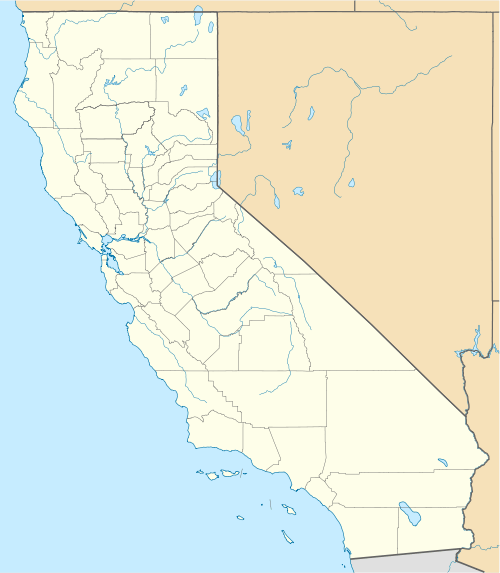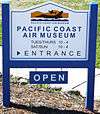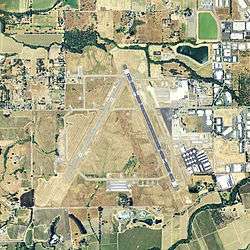Charles M. Schulz–Sonoma County Airport
| Charles M. Schulz–Sonoma County Airport (former Santa Rosa Army Airfield) | |||||||||||||||
|---|---|---|---|---|---|---|---|---|---|---|---|---|---|---|---|
.png) | |||||||||||||||
|
USGS 2006 orthophoto | |||||||||||||||
| IATA: STS – ICAO: KSTS – FAA LID: STS | |||||||||||||||
| Summary | |||||||||||||||
| Airport type | Public | ||||||||||||||
| Owner/Operator | Sonoma County DOT | ||||||||||||||
| Location | Sonoma County, near Santa Rosa, California | ||||||||||||||
| Elevation AMSL | 129 ft / 39 m | ||||||||||||||
| Coordinates | 38°30′32″N 122°48′46″W / 38.50889°N 122.81278°WCoordinates: 38°30′32″N 122°48′46″W / 38.50889°N 122.81278°W | ||||||||||||||
| Website |
SonomaCountyAirport | ||||||||||||||
| Map | |||||||||||||||
 STS Location in California | |||||||||||||||
| Runways | |||||||||||||||
| |||||||||||||||
| Statistics (2014) | |||||||||||||||
| |||||||||||||||
Charles M. Schulz–Sonoma County Airport (IATA: STS, ICAO: KSTS, FAA LID: STS) is 7 miles (11 km) northwest of downtown Santa Rosa, in Sonoma County, California.[1][2]
The airport is named after Charles M. Schulz, the famed cartoonist of the Peanuts comic strip, who lived in Santa Rosa for more than 30 years. The airport's logo features Snoopy in World War I flying ace attire atop his Sopwith Camel, that is to say, his doghouse.
History
Military use
In the 1930s Santa Rosa had a small municipal airfield owned by Richfield Oil Corporation next to the Redwood Highway about 6 miles southeast of the present airport. Use of the 3,000-foot sod runway at the earlier airfield was discontinued during World War II as facilities at the present airport improved.[3]
Opened in June 1942 and known as Santa Rosa Army Air Field, the airfield was assigned to Fourth Air Force as a group and replacement training airfield. Known units assigned to Santa Rosa were:
- 354th Fighter Group, March–June 1943
- 357th Fighter Group, June–August 1943
- 363d Fighter Group, August–October 1943
- 367th Fighter Group, October–December 1943
The 478th Fighter Group was permanently assigned to Santa Rosa in December 1943 and began training replacement pilots, who were sent to combat units overseas after graduation.
The airfield was inactivated on January 31, 1946 and turned over to the War Assets Administration for eventual conversion to a civil airport.
Commercial airline flights
From the late 1940s until the mid 1970s Southwest Airways and successors Pacific Air Lines, Air West and Hughes Airwest served Santa Rosa. Southwest Airways Douglas DC-3s followed by Pacific, Air West and Hughes Airwest Fairchild F-27 turboprops primarily flew to San Francisco (SFO).
Commuter airlines operated prop aircraft followed by turboprops to San Francisco from STS until 2001. Service was also flown nonstop to San Jose (SJC) in the Bay Area. During the mid 1970s, Eureka Aero, a commuter air carrier, was operating nonstop service to Eureka and Sacramento as well.[4] In 1985 Westates Airlines operated Convair CV-580 turboprop service nonstop to Los Angeles (LAX) for several months before ceasing all operations; their July 1985 timetable listed 38 round trips a week between Sonoma County Airport and LAX. Other turboprop flights included American Eagle code share service operated by Wings West Airlines for American Airlines nonstop to both San Francisco (SFO) and San Jose (SJC) flown with Fairchild Swearingen Metroliners. In late 1989, American Eagle was operating three departures a day to SFO and four departures a day to SJC with Metro propjets.[5] Reno Air Express also operated flights to San Jose which were flown by Mid Pacific Air on behalf of Reno Air with British Aerospace BAe Jetstream 31 propjets.
During the mid 1980s, United Airlines entered into a code sharing agreement with WestAir, a formerly independent commuter airline that had previously served STS with Cessna 402 prop aircraft and de Havilland Canada DHC-6 Twin Otter turboprops with flights to San Francisco.[6] WestAir then began flying as United Express to SFO until 2001.[7] Turboprop aircraft operated by WestAir as United Express on the San Francisco service included the Embraer EMB-110 Bandeirante, Short 360, British Aerospace BAe Jetstream 31 and Embraer EMB-120 Brasilia.[8]
In 1989, jet service arrived in Santa Rosa: WestAir operating as United Express initiated four weekday British Aerospace BAe 146-200 jet nonstops to Los Angeles which were soon replaced with Embraer EMB-120 Brasilia turboprop flights which then ended in 1991. The Westair BAe 146s were previously the only jet aircraft ever to serve Santa Rosa in scheduled passenger service; however, new jet service operated by Allegiant Air began on May 19, 2016. WestAir previously operated as Stol Air Commuter flying Britten-Norman Islander and Trislander STOL capable prop aircraft to San Francisco. Stol Air Commuter also had administrative offices located in Santa Rosa. United Express then ceased serving Santa Rosa in 2001 and the airport did not have scheduled passenger airline flights for a number of years.
In March 2007 airline service resumed via Horizon Air, a subsidiary of Alaska Airlines, with flights to Seattle–Tacoma and Los Angeles. Horizon then added flights to Portland, Oregon in late 2007, to Las Vegas in early 2008,[9] and to San Diego in mid-2012.
In early 2011 Alaska Airlines announced it would retire its Horizon brand;[10] and all flights operated by Horizon now use the Alaska Airlines name. In June 2012 the airline ended flights from STS to Las Vegas.[11]
As part of an agreement between the airport, Alaska Airlines, and the local enotourism industry announced in January 2012 that passengers are allowed to check a 12 bottle case of wine for free on all Alaska Airlines flights from the airport.[12]
All Alaska Airlines flights from the airport are operated with the 76-seat Bombardier Q400 propjet, the largest and fastest member of the DHC-8 Dash 8 family. Nonstop Q400 service is currently operated by Horizon Air on behalf of Alaska Airlines to Los Angeles (LAX), Orange County (SNA), Portland (PDX), San Diego (SAN) and Seattle (SEA).[13]
New jet service
In March 2016, Allegiant Air announced it would begin McDonnell Douglas MD-83 jet service to Santa Rosa in May 2016. The airline stated it would fly from Santa Rosa nonstop to Las Vegas via McCarran International Airport (LAS) and also nonstop to Phoenix via the Phoenix-Mesa Gateway Airport (AZA).[14] New nonstop Allegiant jet service to Las Vegas was introduced on May 19, 2016 and several days later to the Phoenix area. The MD-83 was the largest aircraft type ever to provide scheduled passenger service into STS. As of October 19, 2016, Allegiant Air transitioned its flights to Sonoma County from the 166 seat MD-83 to the 155 seat Airbus A319 jetliner.
In October 2016, American Airlines announced it would commence nonstop service between Santa Rosa and its hub in Phoenix (PHX) on February 16, 2017. The daily flight will be operated by SkyWest Airlines operating as American Eagle with Canadair CRJ-700 regional jet aircraft.
Facilities
The airport covers 1,014 acres (410 ha) at an elevation of 129 feet (39 m). It has two asphalt runways: 2/20 is 5,202 by 100 feet (1,586 x 30 m) and 14/32 is 6,000 by 150 feet (1,829 x 46 m).[1]
In 2007 the airport had 128,875 aircraft operations, average 353 per day: 95% general aviation, 4% air taxi, 1% airline and <1% military. 350 aircraft were then based at this airport: 86% single-engine, 11% multi-engine, 2% jet, 1% glider and <1% helicopter.[1]
In August 2013 the airport started a project to decouple the ends of the two runways and extend runway 14/32 by 885 feet, to 6000 feet and extend runway 2/20 by 200 feet, to 5202 feet. This project was scheduled for completion in November 2014.[15] [16]
Airlines and destinations
Passenger
| Airlines | Destinations |
|---|---|
| Alaska Airlines operated by Horizon Air | Los Angeles, Orange County, Portland (OR), San Diego, Seattle/Tacoma |
| Allegiant Air | Las Vegas, Phoenix/Mesa (ends January 2, 2017)[17] |
| American Eagle | Phoenix–Sky Harbor (begins February 16, 2017)[17] |
Statistics
| Rank | Airport | Passengers | Carriers |
|---|---|---|---|
| 1 | Los Angeles, California | 57,000 | Alaska |
| 2 | Seattle/Tacoma, Washington | 27,000 | Alaska |
| 3 | Portland, Oregon | 22,000 | Alaska |
| 4 | San Diego, California | 21,000 | Alaska |
The maximum number of people to Los Angeles in one year is 55,480- 83,200 people on two daily flights. During heavy travel months there will be three flights a day to Los Angeles. The maximum number of people to travel to Seattle, Portland, and San Diego in one year is 27,740 people. Each of these three destinations is served with one daily flight.
Depending on the specific month of the year, current Alaska Airlines service operated by Horizon Air features a total Seven or eight departures a day from Santa Rosa with two or three nonstop flights a day to Los Angeles (LAX), one or two nonstop flights to Portland (PDX), Seattle (SEA), and one nonstop flight a day to Orange County (SNA), and San Diego (SAN).[18]
Other uses
Sonoma Air Attack Base
The Sonoma Air Attack Base of the California Department of Forestry and Fire Protection (known as CDF or CAL FIRE) was established in 1964 and is located at the northeast corner of the airport. Sonoma responds to an average of 300 calls per year. Staff at the base consists of one battalion chief and one fire captain (air tactics group supervisors), one fire apparatus engineer (base manager), and six firefighters. The complement of aircraft located at Sonoma includes one OV-10 Bronco twin turboprop aircraft (Air Attack 140) and two Grumman S-2 Tracker twin turboprop air tankers (classified as S-2T's, Tankers 85 and 86.)

On average, the base pumps about 300,000 US gallons (1,000 m3) of retardant a year. With the base’s pumps, four loading pits and equipment, Sonoma has a possible peak output of 120,000 US gallons (450 m3) of retardant each day. The base’s immediate response area covers 4,000 square miles (10,000 km2) and includes Marin County and portions of the CDF Sonoma–Lake–Napa, Santa Clara, San Mateo–Santa Cruz, and Mendocino Units.
Pacific Coast Air Museum
The Pacific Coast Air Museum is located on the southeast corner of the airport, next to the airplane hangar used in the 1963 Hollywood all-star comedy movie, It's a Mad, Mad, Mad, Mad World. Known as the Butler Building, the hangar was built during World War II, and is still in use today.
See also
References
| Wikimedia Commons has media related to Charles M. Schulz–Sonoma County Airport. |
- 1 2 3 4 FAA Airport Master Record for STS (Form 5010 PDF), effective 2016-02-04.
- ↑ "Sonoma County Airport". Geographic Names Information System. United States Geological Survey. Retrieved 2009-05-04.
- ↑ Freeman, Paul. "Santa Rosa Municipal Airport, Santa Rosa, CA". Tripod.com. Retrieved 2011-12-13.
- ↑ http://www.departed flights.com, April 15, 1975 Eureka Aero route map
- ↑ http://www.departedflights.com, Dec. 15, 1989 Official Airline Guide (OAG), San Francisco-Santa Rosa & San Jose-Santa Rosa flight schedules
- ↑ http://www.departedflights.com, April 1, 1981 & Feb. 15, 1985 editions, Official Airline Guide (OAG), San Francisco-Santa Rosa flight schedules
- ↑ "United Express Discontinues Flights". Los Angeles Times. November 1, 2001.
- ↑ http://www.departedflights.com, Dec. 15, 1989 & Oct, 1, 1991 & April 2, 1995 editions, Official Airline Guide (OAG), San Francisco-Santa Rosa flight schedules
- ↑ Steve Hart (March 25, 2012). "Alaska Airlines service energizes Sonoma County airport". Santa Rosa Press-Democrat.
- ↑ Mutzabaugh, Ben (January 26, 2011). "Horizon Air to 'retire its public brand' in favor of Alaska Air". USA Today.
- ↑ Robert Digitale (July 17, 2012). "Sonoma County-San Diego flights boost Alaska Air ridership". Santa Rosa Press-Democrat.
- ↑ Dan Verel (January 20, 2012). "Tourism bureau, Alaska Air to jointly promote region". North Bay Business Journal.
- ↑ http://www.alaskaair.com, Timetables
- ↑ Mutzabaugh, Ben (March 8, 2016). "Fast-growing Allegiant adds 3 new cities, 22 new routes". USA Today. Retrieved March 8, 2016.
- ↑ http://stsrunwayproject.org/general-information. Retrieved 2014-02-04. Missing or empty
|title=(help) - ↑ Brown, Matt. "Sonoma County airport expansion expected to be completed before next winter". Retrieved 2014-02-04.
- 1 2 http://www.pressdemocrat.com/business/6380559-181/allegiant-air-to-end-service?artslide=0
- ↑ http://www.alaskaair.com, Timetables
External links
- Official website
- Sonoma County Sheriff Helicopter Unit
- FAA Airport Diagram (PDF), effective December 8, 2016
- FAA Terminal Procedures for STS, effective December 8, 2016
- Resources for this airport:
- FAA airport information for STS
- AirNav airport information for KSTS
- ASN accident history for STS
- FlightAware airport information and live flight tracker
- NOAA/NWS latest weather observations
- SkyVector aeronautical chart, Terminal Procedures
![]() This article incorporates public domain material from the Air Force Historical Research Agency website http://www.afhra.af.mil/.
This article incorporates public domain material from the Air Force Historical Research Agency website http://www.afhra.af.mil/.

.svg.png)